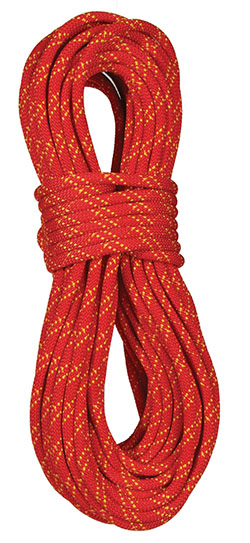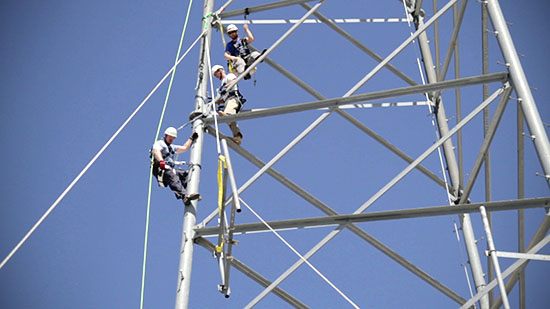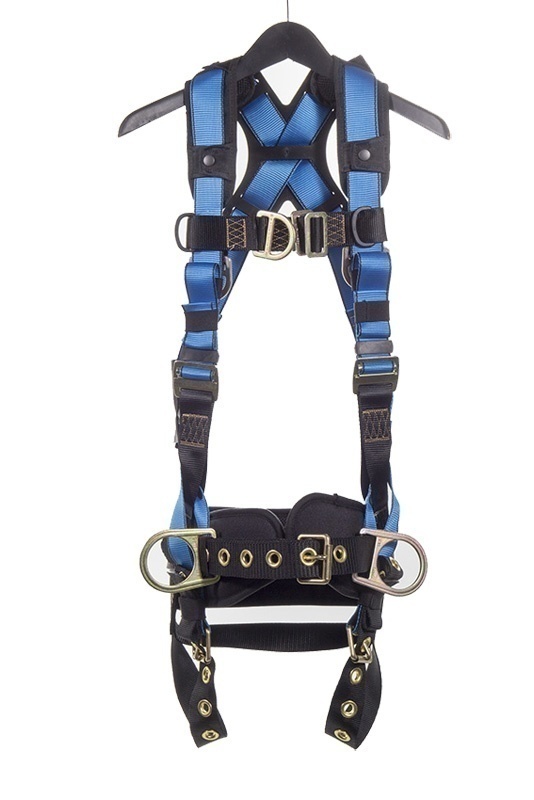 Safety rope
Safety rope is one of the most integral parts of a fall protection system. Unfortunately, there isn’t currently a way to test the break strength of a rope without… well… breaking it. So knowing how to inspect your ropes for damage, as well as knowing when to retire a rope, is a vital skill. This is a task that should be done every time before a rope is used. Yes, it will take a few extra minutes before work can start, but the alternative can keep you off the job for a lot longer.
**DISCLAIMER! Obviously it’s impossible to write exactly when to retire a rope since every situation is different. This is just a basic outline of the process to help determine the safety of a rope!**
First, determine the age of the rope. The best way is to keep the label that has the sales date, and manufacture date printed. If for some reason the rope didn’t include a tag, or you somehow lost itÂ-which doesn’t sound like a thing you’d do-you can cut a small section from the end of the rope to reveal the core yarns. Between those there is a control thread or tape which will reveal the date the rope was made. This can either be printed clearly, or there may be a color coded thread. Check with the particular manufacturer to decipher the code. You can still use the rope, just remelt the end to
fuse the fibers.
As a general rule, if the rope is over 5 years old, it’s time to retire the line. Synthetic fibers start to break down because of UV rays, heat, chemicals, etc., so 5 years is generally the lifespan of a climbing rope. That number might be lower if the rope is used daily.
Some manufacturers recommend keeping a rope diary. A simple log that shows how, when, where, and for how long each rope was used. You should note if the rope was taken over any hard edges, or if it was involved in a fall of any kind. This can help to make a good judgment call on when to replace the rope.
Next, look over the sheath. If there are any cuts in the sheath at all, it’s that rope’s time. Another, more subtle sign is if any of the strands are broken. A little fraying or fuzziness is usually ok, but if there’s a single piece of string sticking out by itself, that’s a warning that the sheath is beginning to wear down. These things seem little, but it’s better to stop is while the problem is small!

Discolorations or stains in the rope can mean that it was exposed to chemicals, paint, or left too long in the sun. All of which can weaken the rope. Also, feel to make sure there’s not a stiff or hardened spot along the length of the rope.
Finally, feel along with the core of the rope for any lumps, knot-like bulges or for any foreign objects that might have made their way through the sheath.
Again… you should always read the manufacturer instructions regarding inspection, use, and care of your rope. They know their product best!
 Safety rope is one of the most integral parts of a fall protection system. Unfortunately, there isn’t currently a way to test the break strength of a rope without… well… breaking it. So knowing how to inspect your ropes for damage, as well as knowing when to retire a rope, is a vital skill. This is a task that should be done every time before a rope is used. Yes, it will take a few extra minutes before work can start, but the alternative can keep you off the job for a lot longer.
**DISCLAIMER! Obviously it’s impossible to write exactly when to retire a rope since every situation is different. This is just a basic outline of the process to help determine the safety of a rope!**
First, determine the age of the rope. The best way is to keep the label that has the sales date, and manufacture date printed. If for some reason the rope didn’t include a tag, or you somehow lost itÂ-which doesn’t sound like a thing you’d do-you can cut a small section from the end of the rope to reveal the core yarns. Between those there is a control thread or tape which will reveal the date the rope was made. This can either be printed clearly, or there may be a color coded thread. Check with the particular manufacturer to decipher the code. You can still use the rope, just remelt the end to fuse the fibers.
As a general rule, if the rope is over 5 years old, it’s time to retire the line. Synthetic fibers start to break down because of UV rays, heat, chemicals, etc., so 5 years is generally the lifespan of a climbing rope. That number might be lower if the rope is used daily.
Some manufacturers recommend keeping a rope diary. A simple log that shows how, when, where, and for how long each rope was used. You should note if the rope was taken over any hard edges, or if it was involved in a fall of any kind. This can help to make a good judgment call on when to replace the rope.
Next, look over the sheath. If there are any cuts in the sheath at all, it’s that rope’s time. Another, more subtle sign is if any of the strands are broken. A little fraying or fuzziness is usually ok, but if there’s a single piece of string sticking out by itself, that’s a warning that the sheath is beginning to wear down. These things seem little, but it’s better to stop is while the problem is small!
Safety rope is one of the most integral parts of a fall protection system. Unfortunately, there isn’t currently a way to test the break strength of a rope without… well… breaking it. So knowing how to inspect your ropes for damage, as well as knowing when to retire a rope, is a vital skill. This is a task that should be done every time before a rope is used. Yes, it will take a few extra minutes before work can start, but the alternative can keep you off the job for a lot longer.
**DISCLAIMER! Obviously it’s impossible to write exactly when to retire a rope since every situation is different. This is just a basic outline of the process to help determine the safety of a rope!**
First, determine the age of the rope. The best way is to keep the label that has the sales date, and manufacture date printed. If for some reason the rope didn’t include a tag, or you somehow lost itÂ-which doesn’t sound like a thing you’d do-you can cut a small section from the end of the rope to reveal the core yarns. Between those there is a control thread or tape which will reveal the date the rope was made. This can either be printed clearly, or there may be a color coded thread. Check with the particular manufacturer to decipher the code. You can still use the rope, just remelt the end to fuse the fibers.
As a general rule, if the rope is over 5 years old, it’s time to retire the line. Synthetic fibers start to break down because of UV rays, heat, chemicals, etc., so 5 years is generally the lifespan of a climbing rope. That number might be lower if the rope is used daily.
Some manufacturers recommend keeping a rope diary. A simple log that shows how, when, where, and for how long each rope was used. You should note if the rope was taken over any hard edges, or if it was involved in a fall of any kind. This can help to make a good judgment call on when to replace the rope.
Next, look over the sheath. If there are any cuts in the sheath at all, it’s that rope’s time. Another, more subtle sign is if any of the strands are broken. A little fraying or fuzziness is usually ok, but if there’s a single piece of string sticking out by itself, that’s a warning that the sheath is beginning to wear down. These things seem little, but it’s better to stop is while the problem is small!
 Discolorations or stains in the rope can mean that it was exposed to chemicals, paint, or left too long in the sun. All of which can weaken the rope. Also, feel to make sure there’s not a stiff or hardened spot along the length of the rope.
Finally, feel along with the core of the rope for any lumps, knot-like bulges or for any foreign objects that might have made their way through the sheath.
Again… you should always read the manufacturer instructions regarding inspection, use, and care of your rope. They know their product best!
Discolorations or stains in the rope can mean that it was exposed to chemicals, paint, or left too long in the sun. All of which can weaken the rope. Also, feel to make sure there’s not a stiff or hardened spot along the length of the rope.
Finally, feel along with the core of the rope for any lumps, knot-like bulges or for any foreign objects that might have made their way through the sheath.
Again… you should always read the manufacturer instructions regarding inspection, use, and care of your rope. They know their product best!












